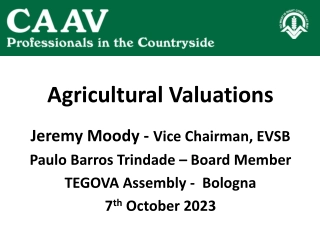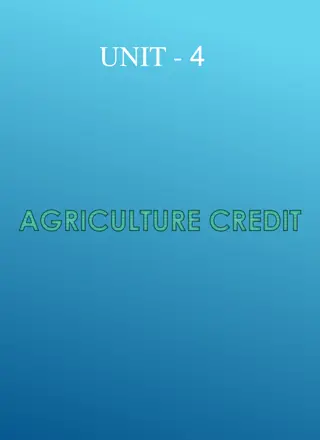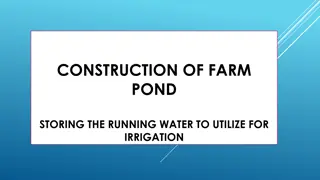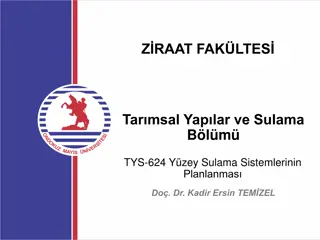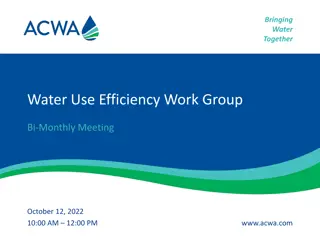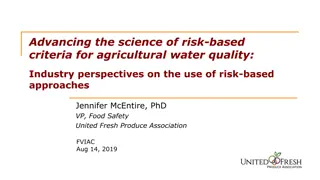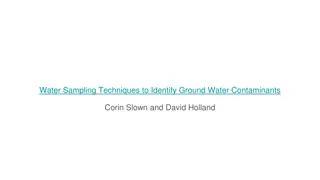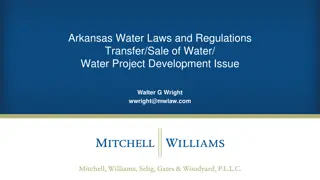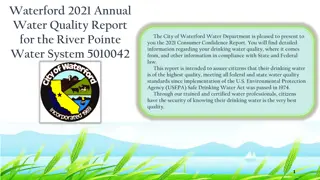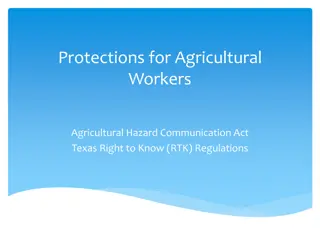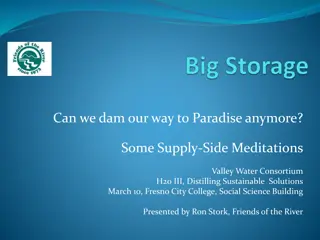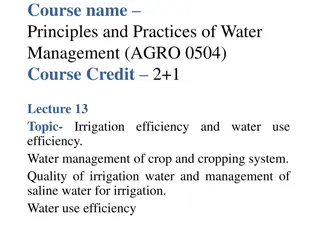Agricultural Water Safety Regulations Overview
The final Produce Rule and Preventive Controls Rule, effective since November 13, 2015, set criteria for microbial contamination in agricultural water. Generic E. coli levels are key indicators, affecting water uses in post-harvest and production. Criteria like Geometric Mean and Statistical Threshold Value determine contamination levels. Testing frequency varies based on water sources, with untreated surface water considered high risk. Compliance deadlines and regulations aim to enhance produce safety and prevent contamination risks.
Download Presentation

Please find below an Image/Link to download the presentation.
The content on the website is provided AS IS for your information and personal use only. It may not be sold, licensed, or shared on other websites without obtaining consent from the author. Download presentation by click this link. If you encounter any issues during the download, it is possible that the publisher has removed the file from their server.
E N D
Presentation Transcript
The Produce rule and Preventive Controls rule is final and effective as of November 13, 2015. Earliest compliance date is two years from the effective date for some farms. Final rule is a combination of the original proposal and revisionsoutlined in the supplemental proposal.
Agricultural Water Final rule establishes two sets of criteria for microbial contamination Both based on the presence of Generic e-coli. Generic e-coli is an indicator/marker for the presence of fecal contamination in water.
Agricultural Water used for Post Harvest (GMPs) No detectable levels of generic e-coli are allowed for certain uses of agricultural water. These include; Water used for washing hands during or after harvest. Water used on food contact surfaces. Water that makes direct contact with produce. Water used to make ice. Water used for sprout irrigation.
Agricultural Water applied to Produce (1) Water that is directly applied to growing produce (sprouts). Criteria are based on two values. Geometric mean (GM) and the Statistical Threshold Value (STV) The GM of samples is 126 or less CFU of Generic e-coli per 100mL of water. The STV of samples is 410 or less CFU per 100mL of water.
Agricultural Water applied to Produce (2) Geometric Mean (GM) The GM is an average. Represents the central tendency and quality of the water source. Statistical Threshold Value (STV) Reflects the amount of variability in water quality at each source. Takes into account adverse conditions. To simplify; it is the level at which 90 percent of samples taken are below the value.
Agricultural Water Testing (1) Testing frequency based on the type of water source. Untreated surface water or ground water. FDA requires an initial water survey based on the risk factors associated with the type of water.
Agricultural Water Untreated Surface Water (1) Considered high risk. Initial survey uses a minimum of 20 samples per source. Samples to be taken as close to harvest as is practical. Samples to be collected over a period of 2 to 4 years. Survey findings are used to calculate both the GM and STV. GM and STV are used to determine the Water Quality Profile (WQP) used to determine if the water source meets the required microbial standards.
Agricultural Water Untreated Surface Water (2) After initial survey an annual survey of a minimum of (5) samples per source is required. Annual values used to update calculations of GM and STV. 5 new samples plus 15 most recent from previous years creates a rolling dataset of 20 samples. Results of the 2o samples confirm the GM and STV are still in acceptable limits.
Agricultural Water Untreated Ground Water (1) Considered lower risk. Initial survey uses a minimum of 4 samples per source. Samples to be taken as close to harvest as is practical. Samples to be collected over a period of 1 year. Survey findings are used to calculate both the GM and STV. GM and STV are used to determine the Water Quality Profile (WQP) used to determine if the water source meets the required microbial standards.
Agricultural Water Untreated Ground Water (2) After initial survey an annual survey of a minimum of (1) sample per source is required. Annual value(s) used to update calculations of GM and STV. The new samples plus (3) most recent from previous years creates a rolling dataset of (4) samples. Results of the (4) samples confirm the GM and STV are still in acceptable limits.
Agricultural Water Untreated Ground Water (3) Untreated Ground Water used for processing. Required testing of (4) samples per year for initial assessment. Farms must make a determination as to the use of this water based on results. If no detectable levels are found than an annual test of (1) sample per year is adequate. If detection occurs farms must return to a (4) sample per growing season test cycle.
Agricultural Water Public Water Systems No requirement to test agricultural water that is supplied by public water systems. Documentation is required to verify public water standards.
Agricultural Water Corrective Actions (1) Corrective Actions (CAs) are required for water sources that do not meet the GM and STV values. CAs are required to be implemented as soon as practical, but no later than the following growing year.
Agricultural Water Corrective Actions (1) Farms have additional flexibility for water sources that do not meet the criteria, including; Allowing time for microbes to die off on the field by using time intervals between last irrigation and harvest; but no more than (4) consecutive days. Allowing time for microbes to die off between harvest and end of storage or to be removed during marketing activities such as washing. Treating the water.
Soil Amendments FDA is conducting a risk assessment and research on the number of days necessary between raw manure application and harvest.
Soil Amendments Raw Manure Currently FDA does not objet to farmers complying with the NOP standard for Raw Manure application. 120 day interval between the application of raw manure for crops in contact with the soil. 90 day interval for between the application of raw manure for crops in contact with the soil. FDA considers the adoption of these standards prudent while the risk assessment is conducted.
Soil Amendments Stabilized Compost Stabilized compost properly prepared using scientifically valid composting practice can be applied. Compost must be applied in a manner that minimizes the potential for contact with covered produce after application.
Domesticated and Wild Animals Farmers are required to reasonably identify and not harvest, isolate or destroy contaminated produce. Growing areas should be monitored for wildlife and animal incursion. Additional assessments where animal incursion is detected and isolation of the areas effected. Final rule, currently, does not require establishing waiting periods between grazing and harvest.
Worker Training , Health and Hygiene GAP principles for training, health and hygiene are contained in the final rule. Sick and ill or injured personnel. Proper hand washing. Training of farm personnel on health and hygiene and its impact on farm food safety. Farm workers and Farm supervisors are required to have a combination of training, education and experience necessary for their assigned task or responsibility.
Equipment, Tools and Buildings Equipment, Tool and Infrastructure must be maintained in a way that they do not contribute to the contamination of produce. The rule covers greenhouses, germination chambers and other structures, as well as toilet and hand washing facilities. Appropriate storage, maintenance and cleaning of equipment and tools on a routine basis are covered under the rule.
Rarely Consumed Raw Commodities Asparagus Black Beans Kidney Beans Lima Beans Navy Beans Cranberries Garden Beets Sugar Beets Collards Sweet Corn Lentils Okra Peppermint Potatoes Pumpkins Winter Squash Sweet Potatoes
Exemptions Produce that is used for on farm or personal consumption. Farms that have an average annual value of produce sold during the previous three year period of 25,000 or less. The rule also provides an exemption for produce that receives commercial processing that reduces the presence of micro-organisms of public health significance.
Qualified Exemptions Modified Requirements The farm must have food sales averaging less than $500,000.00 per year during the previous three years; and The farm s sales to qualified end-users must exceed sales to all others combined during the previous three years. A farm with a qualified exemption(s) must still meet certain requirements. Labeling Certain documentation.
Qualified Exemptions Modified Requirements FDA can withdraw an exemption. A withdrawn exemption may be reinstated.
Variance Requests States can request variances to requirements of the rule. Variances must be backed by research. CQP a possible variance vessel for Massachusetts.
Effective date of rule; November 13, 2015 Very small businesses $25,000.00 to $250,000.00. (4)Four years November 13, 2019 Small businesses, $250,000.00 to $500,000.00. (3) Three years November 13, 2018 All other farms, greater than $500,000 (2)Two years November 13, 2017 Plus an additional 2 years to implement water quality requirements for each category
Effective date of rule; November 13, 2015 Compliance dates for certain aspects of the water quality standards and record keeping provisions add an additional two (2) years to compliance dates Very small businesses $25,000.00 to $250,000.00. (4) Four years November 13, 2019 + (2) 2021
Modified Requirements under Qualified Exemption Labeling Requirement: January 1, 2020 Retention of Records supporting eligibility for a qualified exemption: November 13, 2015 Other modified Requirements VSB (4) Four years SB (3) Three years
Final Rule Preventive Controls for Human Food
Who is covered? Farms must register as food processors if they chop, slice, dice, cook or modify raw agricultural product. Covered facilities must establish and implement a food safety system that includes an analysis of hazards and risk-based preventive controls. Hazard analysis Preventive controls Oversight and management of preventive controls Monitoring Corrective actions and corrections Verification
Farm Definition The definition of a farm is clarified to cover two types of farm operations. Primary Production Farm: This is an operation under one management in one general, but not necessarily contiguous, location devoted to the growing of crops, the harvesting of crops, the raising of animals (including seafood), or any combination of these activities. This kind of farm can pack or hold raw agricultural commodities such as fresh produce and may conduct certain manufacturing/processing activities, such as dehydrating grapes to produce raisins and packaging and labeling raisins.
Farm Definition Secondary Activities Farm: This is an operation not located on the Primary Production Farm that is devoted to harvesting, packing and/or holding raw agricultural commodities. It must be majority owned by the Primary Production Farm that supplies the majority of the raw agricultural commodities harvested, packed, or held by the Secondary Activities Farm. This definition for a Secondary Activities Farm was provided, in part, so that farmers involved in certain formerly off-farm packing now fit under the definition of farm, as the packing is still part of the farming operation. In addition to off-farm produce packing operations, another example of a Secondary Activities Farm could be an operation in which nuts are hulled and dehydrated by an operation not located at the orchard before going to a processing plant. If the farmer that owns the orchards and supplies the majority of the nuts is a majority owner of the hulling/dehydrating facility, that operation is a Secondary Activities Farm.
Who is covered? Primary and Secondary Activities Farms conducting activities on produce, covered by the produce rule will be required to comply with that rule.
Supply Chain Program Supply Chain Program is flexible. Rule mandates that a facility have a risk based supply chain program. Manufacturing processing facilities who rely on a customer to control hazards, do not need to have a supply-chain program for that hazard. Covered food facilities are responsible for ensuring that these foods are received only from approved suppliers. Separate compliance dates have been established for the supply-chain program.
Good Manufacturing Practices Previously non-binding provisions are now binding. Education and Training for employees is now mandatory. Management is required to ensure that employees who manufacture, process, pack or hold food are qualified. Combination of education, training and/or experience. Similar requirements to preventive controls. Allergen cross-contact is now explicit in the regulation.
Compliance Dates Very Small Businesses -(averaging less than $1 million per year (adjusted for inflation) in both annual sales of human food plus the market value of human food manufactured, processed, packed, or held without sale): Three (3) years, except for records to support its status as a very small business (January 1, 2016). Small businesses (a business with fewer than 500 full-time equivalent employees): Two (2) years All other businesses: One(1) year
Compliance Dates Small businesses (a business with fewer than 500 full-time equivalent employees): Two (2) years All other businesses: One(1) year Compliance dates after publication of the final rule for the requirements of the supply chain program:
Compliance Dates Businesses subject to the Pasteurized Milk Ordinance (compliance dates extended to allow time for changes to the PMO safety standards that incorporate the requirements of this preventive controls rule): Three (3) years.
Final Rule Preventive Controls for Human Food




